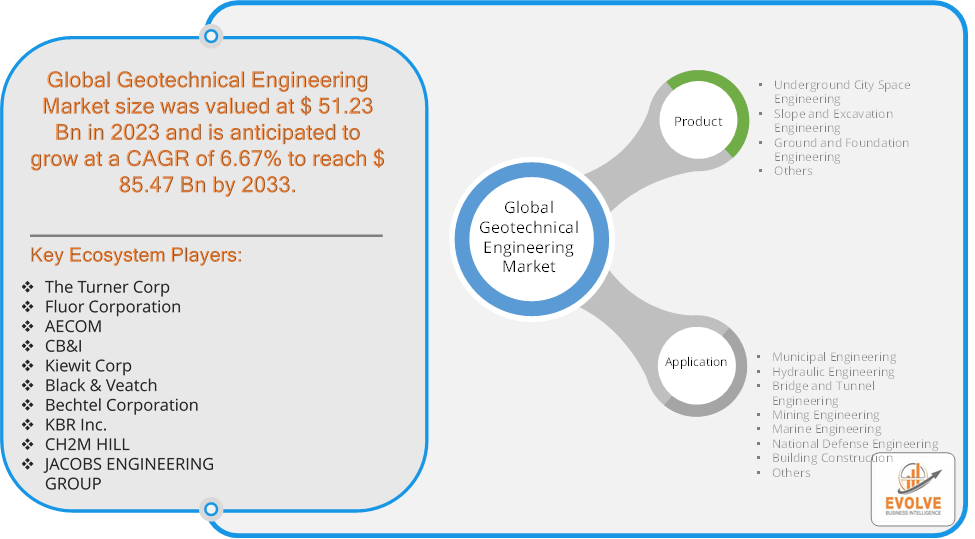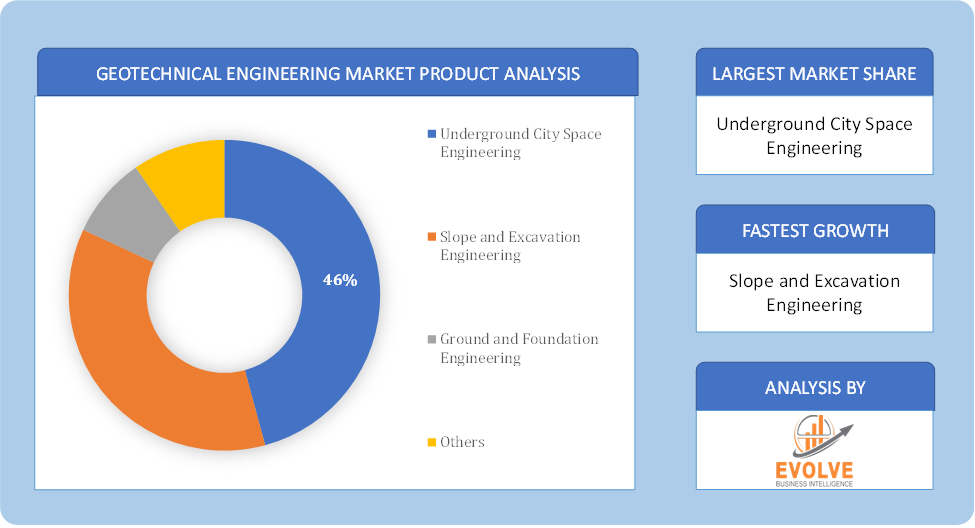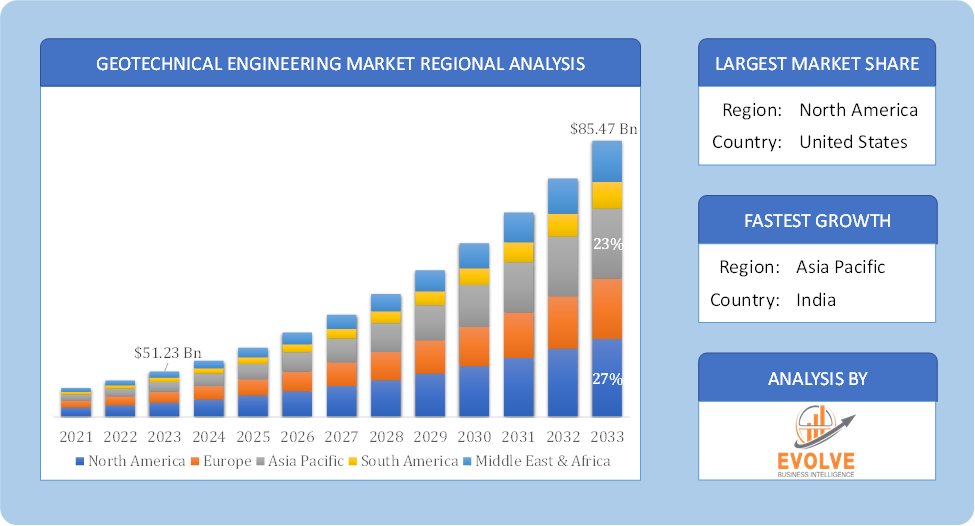Geotechnical Engineering Market Analysis and Global Forecast 2023-2033
$ 1,390.00 – $ 5,520.00Price range: $ 1,390.00 through $ 5,520.00
Geotechnical Engineering Market Research Report: Information By Product Type (Underground City Space Engineering, Slope And Excavation Engineering, Ground And Foundation Engineering), By Application (Municipal Engineering, Hydraulic Engineering, Bridge And Tunnel Engineering, Mining Engineering, Marine Engineering, National Defense Engineering, Building Construction, Others), and by Region — Forecast till 2033
Page: 169
Geotechnical Engineering Market Overview
The Geotechnical Engineering Market Size is expected to reach USD 85.47 Billion by 2033. The Geotechnical Engineering industry size accounted for USD 51.23 Billion in 2023 and is expected to expand at a compound annual growth rate (CAGR) of 6.67% from 2023 to 2033. The geotechnical engineering market encompasses the study and application of soil and rock mechanics to assess the stability of earth structures. It involves analyzing ground conditions for construction projects, infrastructure development, and environmental assessments. Geotechnical engineers provide expertise in foundation design, slope stability, and underground construction, ensuring safety and durability of civil engineering projects. The market includes services like site investigation, soil testing, and geotechnical consulting, crucial for urban development, transportation networks, and energy infrastructure. Demand is driven by construction activities, urbanization trends, and regulatory requirements for sustainable development and risk management.
Global Geotechnical Engineering Market Synopsis
 COVID-19 Impact Analysis
COVID-19 Impact Analysis
The COVID-19 pandemic has led to supply chain disruptions leading to supply shortages or lower demand in the Geotechnical Engineering market. The travel restrictions and social-distancing measures have resulted in a sharp drop in consumer and business spending and this pattern is to continue for some time. The end-user trend and preferences have changed due to the pandemic and have resulted in manufacturers, developers, and service providers adopting various strategies to stabilize the company.
Geotechnical Engineering Market Dynamics
The major factors that have impacted the growth of Geotechnical Engineering are as follows:
Drivers:
Ø Infrastructure Development
Increasing investments in infrastructure projects such as highways, bridges, dams, and tunnels drive demand for geotechnical engineering services. These projects require thorough site investigations, soil testing, and foundation design to ensure structural integrity and safety.
Restraint:
- Technological Challenges
While technological advancements enhance capabilities in geotechnical investigation and analysis, adoption of new technologies may require substantial investments in training and equipment. Small to medium-sized firms may face challenges in keeping pace with rapid technological developments.
Opportunity:
⮚ Technological Advancements
Innovations in geotechnical instrumentation, data analytics, and modeling software offer opportunities to enhance the efficiency and accuracy of site investigations and engineering design. Adoption of advanced technologies enables engineers to deliver more precise assessments and innovative solutions to clients.
Geotechnical Engineering Segment Overview
By Product Type

Based on Product Type, the market is segmented based on Underground City Space Engineering, Slope And Excavation Engineering, Ground And Foundation Engineering. Ground and Foundation Engineering dominates the geotechnical engineering market product types, as it encompasses essential services like soil investigation, foundation design, and ground improvement techniques crucial for infrastructure projects and urban development. These services are fundamental in ensuring structural stability and longevity of construction projects worldwide.
By Application
Based on Applications, the market has been divided into the Municipal Engineering, Hydraulic Engineering, Bridge And Tunnel Engineering, Mining Engineering, Marine Engineering, National Defense Engineering, Building Construction, Others. In the geotechnical engineering market, building construction dominates due to extensive demand for foundation design, soil testing, and site investigations essential for safe and durable construction projects worldwide.
Global Geotechnical Engineering Market Regional Analysis
Based on region, the global Geotechnical Engineering market has been divided into North America, Europe, Asia-Pacific, the Middle East & Africa, and Latin America. North America is projected to dominate the use of the Geotechnical Engineering market followed by the Asia-Pacific and Europe regions.

Geotechnical Engineering North America Market
North America holds a dominant position in the Geotechnical Engineering Market. In 2022, the geotechnical engineering market in North America held a 45.80% market share. Because construction operations require tight regulatory permits, geotechnical engineering services are necessary for an accurate assessment. The growth of the mining and oil and gas sectors is also responsible for the geotechnical engineering market’s rise in this region.
Geotechnical Engineering Asia-Pacific Market
The Asia-Pacific region has indeed emerged as the fastest-growing market for the Geotechnical Engineering industry. From 2023 to 2032, the geotechnical engineering market in Asia Pacific is anticipated to grow at a substantial rate. This is because the infrastructure in this area has been developing at a faster rate. The presence of significant growing economies like China, India, Japan, Korea, and Indonesia, as well as their quick industrial development, contribute to the market’s growth. Because of the large investments made in building projects, this area is leading the way in the application of geotechnical engineering services.
Competitive Landscape
The global Geotechnical Engineering market is highly competitive, with numerous players offering a wide range of software solutions. The competitive landscape is characterized by the presence of established companies, as well as emerging startups and niche players. To increase their market position and attract a wide consumer base, the businesses are employing various strategies, such as product launches, and strategic alliances.
Prominent Players:
- The Turner Corp
- Fluor Corporation
- AECOM
- CB&I
- Kiewit Corp
- Black & Veatch
- Bechtel Corporation
- KBR Inc.
- CH2M HILL
- JACOBS ENGINEERING GROUP
Key Development
July 2021: The largest supplier of geotechnical and environmental engineering services in the US, Geotechnology, Inc., was acquired by Universal Engineering Sciences® (UES), a US-based engineering service provider. Through this acquisition, UES will be able to better serve its clients and expand its market reach.
Scope of the Report
Global Geotechnical Engineering Market, by Product
- Underground City Space Engineering
- Slope and Excavation Engineering
- Ground and Foundation Engineering
- Others
Global Geotechnical Engineering Market, by Application
- Municipal Engineering
- Hydraulic Engineering
- Bridge and Tunnel Engineering
- Mining Engineering
- Marine Engineering
- National Defense Engineering
- Building Construction
- Others
Global Geotechnical Engineering Market, by Region
- North America
- US
- Canada
- Mexico
- Europe
- UK
- Germany
- France
- Italy
- Spain
- Benelux
- Nordic
- Rest of Europe
- Asia Pacific
- China
- Japan
- South Korea
- Indonesia
- Austalia
- Malaysia
- India
- Rest of Asia Pacific
- South America
- Brazil
- Argentina
- Rest of South America
- Middle East & Africa
- Saudi Arabia
- UAE
- Egypt
- South Africa
- Rest of Middle East & Africa
| Parameters | Indicators |
|---|---|
| Market Size | 2033: USD 85.47 Billion |
| CAGR (2023-2033) | 6.67% |
| Base year | 2022 |
| Forecast Period | 2023-2033 |
| Historical Data | 2021 (2017 to 2020 On Demand) |
| Report Coverage | Revenue Forecast, Competitive Landscape, Growth Factors, and Trends |
| Key Segmentations | Product Type, Application |
| Geographies Covered | North America, Europe, Asia-Pacific, South America, Middle East, Africa |
| Key Vendors | The Turner Corp, Fluor Corporation, AECOM, CB&I, Kiewit Corp, Black & Veatch, Bechtel Corporation, KBR Inc., CH2M HILL, JACOBS ENGINEERING GROUP. |
| Key Market Opportunities | · Technological advancements |
| Key Market Drivers | · Rising investment in wind energy and high growth in construction industry |
REPORT CONTENT BRIEF:
- High-level analysis of the current and future Geotechnical Engineering market trends and opportunities
- Detailed analysis of current market drivers, restraining factors, and opportunities in the future
- Geotechnical Engineering market historical market size for the year 2021, and forecast from 2023 to 2033
- Geotechnical Engineering market share analysis at each product level
- Competitor analysis with detailed insight into its product segment, Government & Defense strength, and strategies adopted.
- Identifies key strategies adopted including product launches and developments, mergers and acquisitions, joint ventures, collaborations, and partnerships as well as funding taken and investment done, among others.
- To identify and understand the various factors involved in the global Geotechnical Engineering market affected by the pandemic
- To provide a detailed insight into the major companies operating in the market. The profiling will include the Government & Defense health of the company’s past 2-3 years with segmental and regional revenue breakup, product offering, recent developments, SWOT analysis, and key strategies.
Frequently Asked Questions (FAQ)
What is the study period of this market?
The study period of the global Geotechnical Engineering market is 2021- 2033
What is the growth rate of the global Geotechnical Engineering market?
The global Geotechnical Engineering market is growing at a CAGR of 6.67% over the next 10 years
Which region has the highest growth rate in the market of Geotechnical Engineering?
Asia Pacific is expected to register the highest CAGR during 2023-2033
Which region has the largest share of the global Geotechnical Engineering market?
North America holds the largest share in 2022
Who are the key players in the global Geotechnical Engineering market?
The Turner Corp, Fluor Corporation, AECOM, CB&I, Kiewit Corp, Black & Veatch, Bechtel Corporation, KBR Inc., CH2M HILL, and JACOBS ENGINEERING GROUP are the major companies operating in the market.
Do you offer Post Sale Support?
Yes, we offer 16 hours of analyst support to solve the queries
Do you sell particular sections of a report?
Yes, we provide regional as well as country-level reports. Other than this we also provide a sectional report. Please get in contact with our sales representatives.
Press Release

Global Pharmaceutical Manufacturing Market to Reach $1.38 Trillion by 2035 with 7.35% CAGR, New Research Shows

The Global Mammography Market Is Estimated To Record a CAGR of Around 10.29% During The Forecast Period

Glue Stick Market to Reach USD 2.35 Billion by 2034

Podiatry Service Market to Reach USD 11.88 Billion by 2034

Microfluidics Technology Market to Reach USD 32.58 Billion by 2034

Ferric Chloride Market to Reach USD 10.65 Billion by 2034

Family Practice EMR Software Market to Reach USD 21.52 Billion by 2034

Electric Hairbrush Market to Reach USD 15.95 Billion by 2034

Daily Bamboo Products Market to Reach USD 143.52 Billion by 2034

Cross-border E-commerce Logistics Market to Reach USD 112.65 Billion by 2034
Table of Content
Chapter 1. Executive Summary Chapter 2. Scope Of The Study 2.1. Market Definition 2.2. Scope Of The Study 2.2.1. Objectives of Report 2.2.2. Limitations 2.3. Market Structure Chapter 3. Evolve BI Methodology Chapter 4. Market Insights and Trends 4.1. Supply/ Value Chain Analysis 4.1.1. Raw Applications Providers 4.1.2. Manufacturing Process 4.1.3. Distributors/Retailers 4.1.4. End-Use Industry 4.2. Porter’s Five Forces Analysis 4.2.1. Threat Of New Entrants 4.2.2. Bargaining Power Of Buyers 4.2.3. Bargaining Power Of Suppliers 4.2.4. Threat Of Substitutes 4.2.5. Industry Rivalry 4.3. Impact Of COVID-19 on the Geotechnical Engineering Market 4.3.1. Impact on Market Size 4.3.2. End-Use Industry Trend, Preferences, and Budget Impact 4.3.3. Regulatory Framework/Government Policies 4.3.4. Key Players' Strategy to Tackle Negative Impact 4.3.5. Opportunity Window 4.4. Technology Overview 12.28. Macro factor 4.6. Micro Factor 4.7. Demand Supply Gap Analysis of the Geotechnical Engineering Market 4.8. Import Analysis of the Geotechnical Engineering Market 4.9. Export Analysis of the Geotechnical Engineering Market Chapter 5. Market Dynamics 5.1. Introduction 5.2. DROC Analysis 5.2.1. Drivers 5.2.2. Restraints 5.2.3. Opportunities 5.2.4. Challenges 5.3. Patent Analysis 5.4. Industry Roadmap 5.5. Parent/Peer Market Analysis Chapter 6. Global Geotechnical Engineering Market, By Product Type 6.1. Introduction 6.2. Underground City Space Engineering 6.3. Slope and Excavation Engineering 6.4. Ground and Foundation Engineering 6.5. Others Chapter 7. Global Geotechnical Engineering Market, By Application 7.1. Introduction 7.2. Municipal Engineering 7.3. Hydraulic Engineering 7.4. Bridge and Tunnel Engineering 7.5. Mining Engineering 7.6. Marine Engineering 7.7. National Defense Engineering 7.8. Building Construction 7.9. Others Chapter 8. Global Geotechnical Engineering Market, By Region 8.1. Introduction 8.2. North America 8.2.1. Introduction 8.2.2. Driving Factors, Opportunity Analyzed, and Key Trends 8.2.3. Market Size and Forecast, By Country, 2023-2033 8.2.4. Market Size and Forecast, By Product Type, 2023-2033 8.2.5. Market Size and Forecast, By Application, 2023-2033 8.2.6. US 8.2.6.1. Introduction 8.2.6.2. Driving Factors, Opportunity Analyzed, and Key Trends 8.2.6.3. Market Size and Forecast, By Product Type, 2023-2033 8.2.6.4. Market Size and Forecast, By Application, 2023-2033 8.2.7. Canada 8.2.7.1. Introduction 8.2.7.2. Driving Factors, Opportunity Analyzed, and Key Trends 8.2.7.4. Market Size and Forecast, By Product Type, 2023-2033 8.2.7.5. Market Size and Forecast, By Application, 2023-2033 8.3. Europe 8.3.1. Introduction 8.3.2. Driving Factors, Opportunity Analyzed, and Key Trends 8.3.3. Market Size and Forecast, By Country, 2023-2033 8.3.4. Market Size and Forecast, By Product Type, 2023-2033 8.3.5. Market Size and Forecast, By Application, 2023-2033 8.3.6. Germany 8.3.6.1. Introduction 8.3.6.2. Driving Factors, Opportunity Analyzed, and Key Trends 8.3.6.3. Market Size and Forecast, By Product Type, 2023-2033 8.3.6.4. Market Size and Forecast, By Application, 2023-2033 8.3.7. France 8.3.7.1. Introduction 8.3.7.2. Driving Factors, Opportunity Analyzed, and Key Trends 8.3.7.3. Market Size and Forecast, By Product Type, 2023-2033 8.3.7.4. Market Size and Forecast, By Application, 2023-2033 8.3.8. UK 8.3.8.1. Introduction 8.3.8.2. Driving Factors, Opportunity Analyzed, and Key Trends 8.3.8.3. Market Size and Forecast, By Product Type, 2023-2033 8.3.8.4. Market Size and Forecast, By Application, 2023-2033 8.3.9. Italy 8.3.9.1. Introduction 8.3.9.2. Driving Factors, Opportunity Analyzed, and Key Trends 8.3.9.3. Market Size and Forecast, By Product Type, 2023-2033 8.3.9.4. Market Size and Forecast, By Application, 2023-2033 8.3.11. Rest Of Europe 8.3.11.1. Introduction 8.3.11.2. Driving Factors, Opportunity Analyzed, and Key Trends 8.3.11.3. Market Size and Forecast, By Product Type, 2023-2033 8.3.11.4. Market Size and Forecast, By Application, 2023-2033 8.4. Asia-Pacific 8.4.1. Introduction 8.4.2. Driving Factors, Opportunity Analyzed, and Key Trends 8.4.3. Market Size and Forecast, By Country, 2023-2033 8.4.4. Market Size and Forecast, By Product Type, 2023-2033 8.12.28. Market Size and Forecast, By Application, 2023-2033 8.4.6. China 8.4.6.1. Introduction 8.4.6.2. Driving Factors, Opportunity Analyzed, and Key Trends 8.4.6.3. Market Size and Forecast, By Product Type, 2023-2033 8.4.6.4. Market Size and Forecast, By Application, 2023-2033 8.4.7. India 8.4.7.1. Introduction 8.4.7.2. Driving Factors, Opportunity Analyzed, and Key Trends 8.4.7.3. Market Size and Forecast, By Product Type, 2023-2033 8.4.7.4. Market Size and Forecast, By Application, 2023-2033 8.4.8. Japan 8.4.8.1. Introduction 8.4.8.2. Driving Factors, Opportunity Analyzed, and Key Trends 8.4.8.3. Market Size and Forecast, By Product Type, 2023-2033 8.4.8.4. Market Size and Forecast, By Application, 2023-2033 8.4.9. South Korea 8.4.9.1. Introduction 8.4.9.2. Driving Factors, Opportunity Analyzed, and Key Trends 8.4.9.3. Market Size and Forecast, By Product Type, 2023-2033 8.4.9.4. Market Size and Forecast, By Application, 2023-2033 8.4.10. Rest Of Asia-Pacific 8.4.10.1. Introduction 8.4.10.2. Driving Factors, Opportunity Analyzed, and Key Trends 8.4.10.3. Market Size and Forecast, By Product Type, 2023-2033 8.4.10.4. Market Size and Forecast, By Application, 2023-2033 8.5. Rest Of The World (RoW) 8.5.1. Introduction 8.5.2. Driving Factors, Opportunity Analyzed, and Key Trends 8.5.3. Market Size and Forecast, By Product Type, 2023-2033 8.5.4. Market Size and Forecast, By Application, 2023-2033 Chapter 9. Company Landscape 9.1. Introduction 9.2. Vendor Share Analysis 9.3. Key Development Analysis 9.4. Competitor Dashboard Chapter 10. Company Profiles 10.1. The Turner Corp 10.1.1. Business Overview 10.1.2. Government & Defense Analysis 10.1.2.1. Government & Defense – Existing/Funding 10.1.3. Product Portfolio 10.1.4. Recent Development and Strategies Adopted 10.1.5. SWOT Analysis 10.2. Fluor Corporation 10.2.1. Business Overview 10.2.2. Government & Defense Analysis 10.2.2.1. Government & Defense – Existing/Funding 10.2.3. Product Portfolio 10.2.4. Recent Development and Strategies Adopted 10.2.5. SWOT Analysis 10.3. AECOM 10.3.1. Business Overview 10.3.2. Government & Defense Analysis 10.3.2.1. Government & Defense – Existing/Funding 10.3.3. Product Portfolio 10.3.4. Recent Development and Strategies Adopted 10.3.5. SWOT Analysis 10.4. CB&I 10.4.1. Business Overview 10.4.2. Government & Defense Analysis 10.4.2.1. Government & Defense – Existing/Funding 10.4.3. Product Portfolio 10.4.4. Recent Development and Strategies Adopted 10.12.28. SWOT Analysis 10.5. Kiewit Corp 10.5.1. Business Overview 10.5.2. Government & Defense Analysis 10.5.2.1. Government & Defense – Existing/Funding 10.5.3. Product Portfolio 10.5.4. Recent Development and Strategies Adopted 10.5.5. SWOT Analysis 10.6. Black & Veatch 10.6.1. Business Overview 10.6.2. Government & Defense Analysis 10.6.2.1. Government & Defense – Existing/Funding 10.6.3. Product Portfolio 10.6.4. Recent Development and Strategies Adopted 10.6.5. SWOT Analysis 10.7. Bechtel Corporation 10.7.1. Business Overview 10.7.2. Government & Defense Analysis 10.7.2.1. Government & Defense – Existing/Funding 10.7.3. Product Portfolio 10.7.4. Recent Development and Strategies Adopted 10.7.5. SWOT Analysis 10.8 KBR Inc. 10.8.1. Business Overview 10.8.2. Government & Defense Analysis 10.8.2.1. Government & Defense – Existing/Funding 10.8.3. Product Portfolio 10.8.4. Recent Development and Strategies Adopted 10.8.5. SWOT Analysis 10.9 CH2M HILL 10.9.1. Business Overview 10.9.2. Government & Defense Analysis 10.9.2.1. Government & Defense – Existing/Funding 10.9.3. Product Portfolio 10.9.4. Recent Development and Strategies Adopted 10.9.5. SWOT Analysis 10.10. JACOBS ENGINEERING GROUP 10.10.1. Business Overview 10.10.2. Government & Defense Analysis 10.10.2.1. Government & Defense – Existing/Funding 10.10.3. Product Portfolio 10.10.4. Recent Development and Strategies Adopted 10.10.5. SWOT Analysis
Connect to Analyst
Research Methodology





